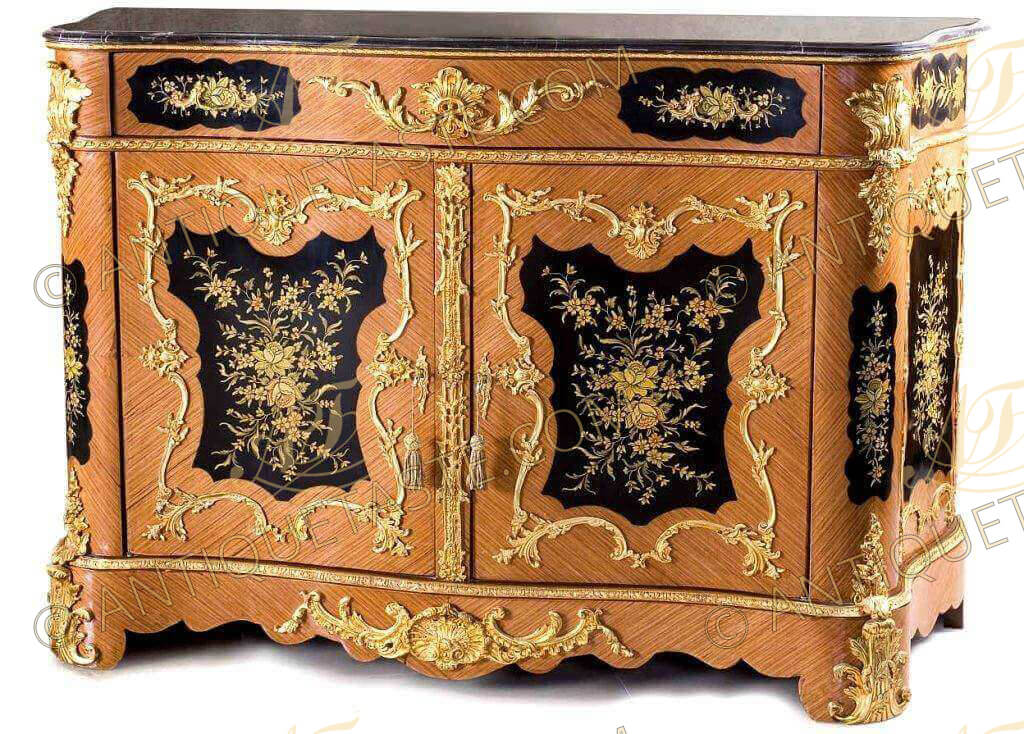Ref#1578 | Description
Enchanting Napoleon III and Rococo style ormolu-mounted veneer inlaid and hand painted side cabinet, after the model Circa 1860, surmounted by a serpentine stepped black marble top above a large frieze drawer with double ormolu bands centered by foliate acanthus mount with foliate scrolls, flanked to each side by a floral painted panel with ormolu foliate handle, above a pair of cupboard doors, each with ormolu keyhole escutcheon and centered by a black background cartouche with spring flowers within a C scrolled and foliate frame with cabuchon, the interior fitted with an adjustable shelf, separated with a very fine chiseled pierced strapwork, the sides each with conforming panels hand painted as well with flowers with a matching ormolu frame of the same work, the scalloped apron centered by a large central ormolu shell issuing C Rococo works, on built-in shaped feet with foliate clasps.
Ref#1578
159 x 110 x 59 cm
The Napoleon III style:
The Napoleon III style is the name commonly given to a 19th-century style of Renaissance Revival architecture in France, especially in Paris. It is a sub-style of Second Empire architecture, which is a term also used elsewhere in the world for this style. It is characterized by its eclecticism, because of the mix of decorative elements from the past. It flourished during the Second French Empire, with the patronage of Napoleon III.
The term "Napoleon III style" (French: style Napoléon III) may be contemporary: legend has it that when the Empress Eugénie asked architect Charles Garnier whether the Palais Garnier, under construction in 1862, would be built in the Greek or Roman style, he replied, "It is in the Napoleon III style, Madame!" The term is also not reserved exclusively for architecture. It is used also to describe furniture of the period, especially in the marketplace, where other "royal period" styles are commonplace.
The style is characterised by high façades, mansard roofs, and, more rarely, pavilions. The buildings are richly decorated but with clearly defined outlines. The Napoleon III style is associated with the renovation of Paris under Baron Haussmann between 1852 and 1870. The buildings of the renovation show a singularity of purpose and design, a consistency of urban planning that was unusual for the period. Numerous public edifices: railway stations, the tribunal de commerce, and the Palais Garnier were constructed in the style.
Tags
- #Napoleon_III_Meuble_A_Hauteaur_D'appui | #Napoleon_III_Rococo_style_Cabinet | #Meuble A Hauteaur D'appui | #Commode a vantaux | #Antoine Gaudreaux Commode | #Jean-Henri Riesener commode | #Marie-Antoinette commode | #Charles Cressent commode | #Maison Millet commode | #Pierre Antoine Foullet commode | #Napoleon III commode | #Martin Carlin commode | #André Charles Boulle commode | #French style commode | #Louis XV commode | #Louis XIV commode | #Louis XVI commode

